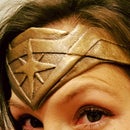Introduction: Ball Point Pen Art
I have always loved art. It is the thing that I can get absolutely lost in. I am amazed by those who can create such lifelike images that fool the eye. There are several amazing ball point pen artists out there with incredible photo realism. I have always wondered if I could do something like that with a ball point pen. So, one day I set out to find out if I could.
I wanted the final project to look like a photograph if you were to step back a bit, but have it be clear up close that it wasn't. I also challenged myself to do this without any pre-drawing at all. I didn't want to have to erase any lines.
As I don't have a lot of extra time either, I actually did this in many small doses of time. For my job, I spend a lot of time on the phone. I am a doodler by nature, and i usually focus a little better when doodling. So, I worked on this while I was on the phone in 10- 20 min. increments over the course of a month or so with each picture. I am really please with how it turned out.
I hope to share some of the tricks and tips that I have learned to be able to do something like this.
Step 1: Materials
I used regular legal sized paper and a ball point pen for this project. Nothing fancy. I also used the internet and a computer to find reference material.
See... anyone can do it... who doesn't have a pen and some paper?
Step 2: Pick a Picture
I wanted to do drawings of some of my heroes. They also needed to be black and white, since I was only going to be using a black pen and white paper. I also find it easier when doing portraits to find someone who is very well known and has a distinctive look to them. Lincoln is definitely that, and Mandela only a little less so. I also like to have a lot of contrast as this will really make a picture pop.
Once I had a picture, I copied it into Word and turned on my rulers. This allowed me to size the picture to be the same (or close) to the size of paper I was going to be drawing on. This will come in very handy for the next step.
Step 3: Grid Concept
When it comes to drawing, I learned some incredible things in college that have really stuck with me and allowed me to continually improve without instruction from professors. The art teacher that had the biggest impact on me in this way was Leon Parson. There was one phrase that he said over and over that really helped me approach drawing in a different way.
"Draw what you see and not what you know, until that happy day that you know what you are seeing"
So often we fall victim to what we think we are seeing based on our understanding of the world. For example, people often draw eyes as this perfect football shape thinking they "know" that is the shape of an eye. However, if you take the time to really look at an eye, its shape is really not that symmetrical on either the horizontal or vertical axis. When we slow down and really take the time to SEE we are able to draw what is really there.
One strategy that has helped many people to start paying attention to what is actually there is the grid system. What this can do is get someone to focus on a specific section of a picture and work on replicating that specific section. Sometimes, people will even turn it upside down to challenge their brain to look at what is actually there. This is true for both the lines and the shades.
In doing this, one would set a grid line on the picture and create an identical one on the paper that will be drawn on. This can also be used to enlarge a picture. Simply increase the proportion size of the drawing grid.
All that said, I didn't set up a specific grid on my paper or the picture. However, my mentality follows this idea. I scope out location on the paper and size of different objects in relation to each other. I have practiced this strategy a lot, and so it comes a bit more naturally to me now.
Step 4: Stippling Variant & Strategy
Wikipedia defines Stippling as such:
Stippling is the creation of a pattern simulating varying degrees of solidity or shading by using small dots. Such a pattern may occur in nature and these effects are frequently emulated by artists.
There are some really amazing artworks that use this strategy. I wanted to have my form of stipple replicate what you might see in the grain of an old photograph. So instead of dots, I used squiggly lines. These varied in size and thickness to create the effect. Some areas also are so covered by by the squiggly lines that very little white shows through. This is how to create light and shadow.
The video shows how this is done (ignore the baby grunts in the background). It takes some time, but you just build it up.
Step 5: Start Drawing
So I found the key to getting into it is to just jump right in. Locate a starting point, make sure it is on the right part of the page proportionally, and start the squiggling. The key is to start light as you work on getting the shape right. I would take a step back occasionally to compare the photograph with my drawing. I could correct any errors in shape.
Once I had the basic shape of an area I would move on to another spot to build the whole drawing. Then more drawing, checking and comparing. During this I am working on getting the right shade/contrast down. My art teacher in high school, Tom Sarmo, taught me that most people don't use enough contrast in their work. Their darks are just not dark enough. I would often bring him something I was working on and he would loudly say, "More Darker!" This is another time to compare the shade of the drawing to the shade of reference photo.
I spend time going back and looking at the whole drawing several times check shape, shade and proportion. Since it is pen, these are all minor adjustments to be made at the end.
Step 6: Put Your Signature on It
Once the full picture is complete, you have to find a good place to place the signature. I like to not allow my signature to distract from the subject matter. In the Lincoln drawing, this is down on the lapel.
This is a fun and challenging project that tested the things I learned through the years. It turned out pretty well. I hope some of the tips and processes I shared can help you try this out as well. I will post pictures of the completed Mandela when I get some time to finish it.
If you liked the instructable, please vote for it in the Crafting 101 contest.

Runner Up in the
Crafting 101












